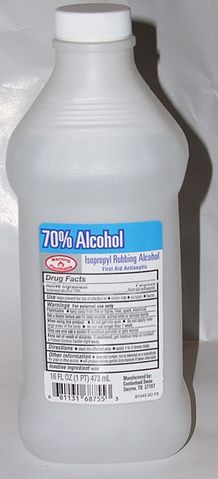Why Rubbing Alcohol Makes Cuts Burn

Get a scrape or a cut and your first step — after the subtle facial expression you make from the pain — may be to grab some rubbing alcohol. Your goal is to clean off the wound before applying a bandage, as you want to shield the scrape from the elements, not trap bacteria or other stuff within the injured area. The rubbing alcohol should do that, but as almost everyone learns at a young age, it comes at a price: once applied, the alcohol makes the cut feel like it’s burning.
But why? What causes that sensation? Is it the bacteria fighting back, in one last blaze of glory before they succumb to a tidal wave of alcohol death?
Sadly, no. But the actual science is still pretty neat. Our skin has a special type of proteins called VR1 receptors which alert the brain when we are exposed to high temperatures. Pouring cold alcohol on a wound, though, shouldn’t trigger a response, as there’s no heat being introduced. But according to one study (which focuses on ethanol, but the same holds true for the more common, isopropyl-based rubbing alcohol as seen above), the alcohol does more to the VR1 receptors than simply wash over them. As Indiana Public Radio explains, the ethanol lowers the temperature threshold needed to trigger a response from the receptors. Specifically, they note, “researchers have found that alcohol lowers the amount of heat needed to turn on VR1 receptors by almost ten degrees.”
That’s only half the story, though. Even if the alcohol can lower our skin’s temperature threshold, we still need a heat source to set off the receptors. Indiana Public Radio shares a theory there, too: “researchers think that ethanol may lower the threshold so much around inflamed tissue that your own body temperature kicks off the VR1 receptors.”
Bonus fact: Want to avoid the rubbing alcohol burn? An easy solution is to skip the alcohol. According to Robert Kirsner, a spokesperson for the American Academy of Dermatology, there’s no need. As he told Reader’s Digest, the alcohol (and other similar treatments, such as iodine or hydrogen peroxide) kill off healthy cells as well as cleaning the wound, and that’s not very useful. His advice: “The most effective way to get rid of debris and bacteria without damaging healthy tissue is flushing the wound out with water.”
From the Archives: Why Diet Coke Loves Mentos: Another reaction — one which is fun.
Related: “American Medical Association Handbook of First Aid and Emergency Care,” a “go-to reference for emergencies that no home will want to be without.” 416 pages, 4.3 stars on 10 reviews. The most negative review (two stars) says that “book is great for when little Jimmy scrapes his knee. This book is great when you have a medical professional 5 minutes away. If you are looking for survival/emergency guide this is not it.”
